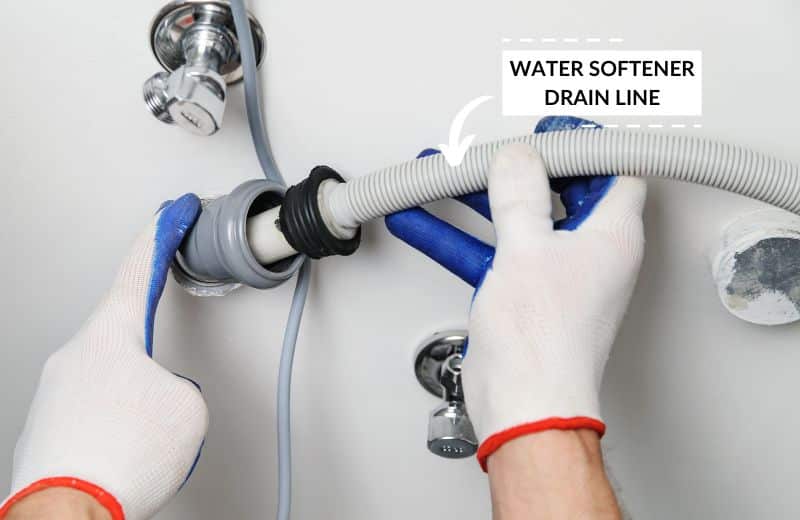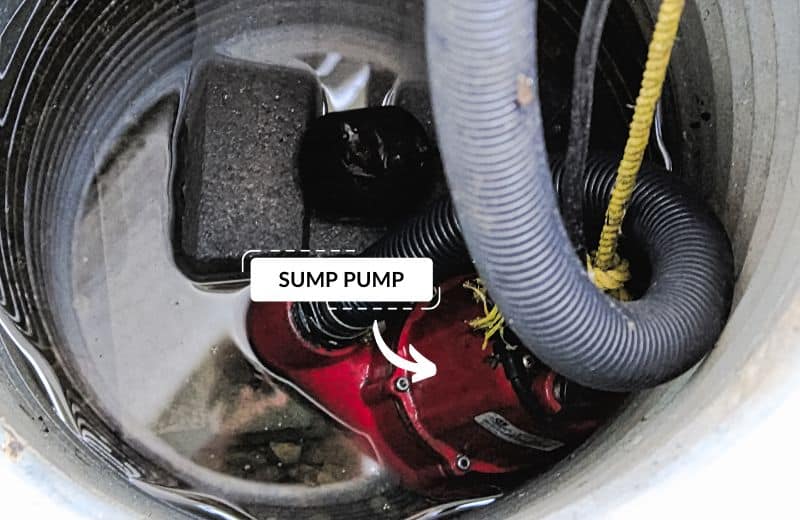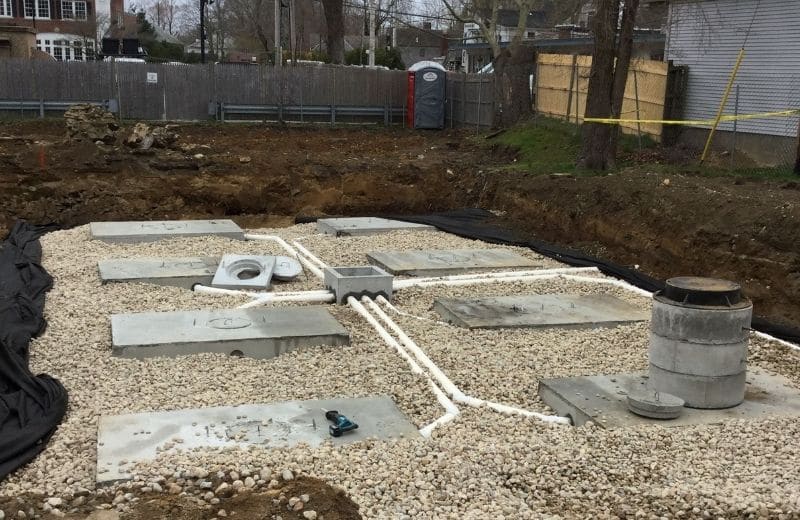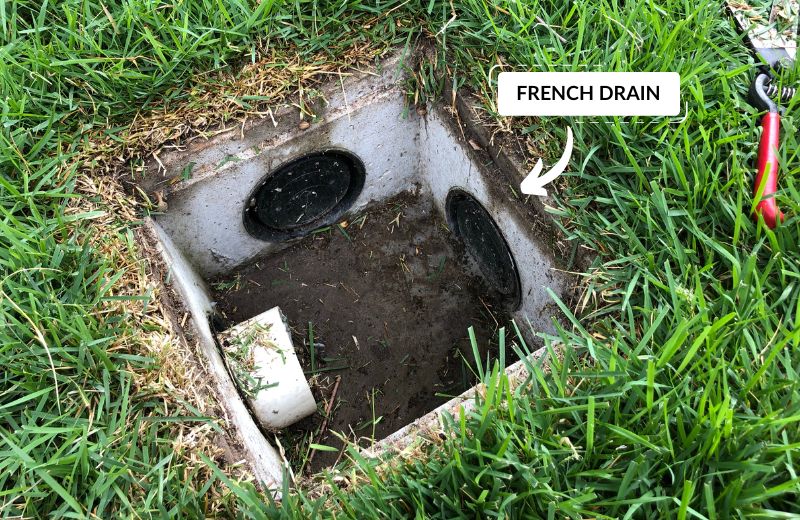Conventional water softeners use the ion exchange process to swap hard water minerals for sodium ions.
In order for this process to be effective in the long term, water softeners need to flush themselves out to remove a buildup of hardness minerals inside the resin. This requires a drain connection.
In this guide, I’ll be sharing everything you should know about water softener drain lines, including how drain lines work, where you can connect them, and how to install a water softener drain pipe.
Table of Contents
🙋 Why Does a Water Softener System Need a Drain Line?
Ion exchange water softeners need to regenerate to keep up with their water softening performance.
Regeneration is the process of flushing the resin bed, which contains calcium and magnesium. During ion exchange, these minerals are removed from water, in exchange for sodium. Eventually, the resin becomes saturated with calcium and magnesium, and the softener must regenerate to remove these minerals and replenish the softening tank with sodium.
During regeneration, water is flushed through the system. This water picks up hardness ions and carries them out of the system. This is where a drain line is needed: to send this water down the drain, ensuring it doesn’t contaminate your home’s water supply with a high concentration of hardness minerals.
Continue Reading: Do all water softeners need a drain?
💭 Where Can You Drain Your Water Softener?
For most people, attaching their water softener’s drain line to their local sewage system during the installation process is the most convenient means of getting rid of backwash water.
If you live in a remote area, however, you may not have a direct connection to a sewage system. Even if you do, your municipality might have specific restrictions that could mean that you can’t discharge backwash into your sewage system.
Importance of Understanding Local Regulations
It’s essential to read up on any rules and regulations that your local authority might have about water softener drainage before you purchase a system.
These regulations could affect the type of system you can purchase, or whether a water softener that regenerates is right for you at all.
There are plenty of options for draining water softener backwash, so don’t worry if local regulations forbid you from flushing the backwash in a certain manner.
For instance, you might not be allowed to drain your water softener backwash onto the ground if your local authority uses groundwater as a source for the public drinking water supply. In this case, you should consider hooking your water softener’s drain pipe to your sewage connection.

Some local authorities might also prohibit you from sending backwash water directly into your sewage line. In this case, you can consider flushing your water softener outside instead.
Can I Drain My Water Softener Outside?
If you don’t want the fuss of hooking your drain line up to your sewage system, one of the easiest options is to simply drain your water onto the ground.
However, you may prefer not to do this for environmental protection purposes. Backwash contains sodium, which may damage your local ecosystem. It could kill nearby plants, and if you have a well on your property, there’s a risk of contamination.
🔷 Backwash Drain Options for the Basement
The options below are best for draining your softener backwash from your basement. If your water softener is installed in your basement, any of these options will likely make sense.
Floor Drain
The simplest option is to use a floor drain. Most water softener units provide enough water pressure to send water up a drainpipe and out of the basement.
If your water softener doesn’t offer enough water pressure to send water up a sewage drain, you can use one of the two pumps mentioned below.
Sump Pump
A sump pump sends water away from the system when the water level reaches a certain height. This type of pump is usually installed in a sump basin.
You can run your water softener’s drain straight into a sump basin. This will trigger the sump pump to pump the backwash to the required height. It will then be drained into your preferred type of drainage, such as a sewage system.
You could combine a sump pump with a dry well in your basement, which would mean that the sump pump would only be required if the well’s soil was unable to take up the backwash.

Sewage Ejector Pump
An alternative pump option is a sewage ejector pump. This system works similarly to a sump pump, and can be used to send water up from a basin to the required height.
The benefit of sewage ejector pumps is that they eject water straight into a sewage system. These pumps use a vent, which prevents raw sewage from flowing back into your drain line. Any gases that may be in the piping will also be vented out.
If you do opt for a pump to assist with drainage, make sure to choose a plastic or stainless steel pump, which won’t be affected by the corrosive nature of your softener’s wastewater brine.
It’s also best to make sure the pump isn’t submerged in water for extended periods of time, which could shorten its lifespan.
🔶 Backwash Drain Options for Outdoor Discharge
For discharging water from your brine tank outside, look into the following options:
Dry Well
A dry well is a simple option for draining your water softener’s backwash. It’s simply a deep hole that enables backwash to slowly seep into the ground.
It’s important that a dry well sirs above the water table, which will make it suitable for holding large quantities of backwash and allowing it to slowly and gradually travel into the earth around the well.
Because dissipation is a slow process, dry wells are a good solution for water softener backwash, as they prevent too much sodium or hardness from getting into your local ecosystem.
Septic Drain Field
When a septic tank is installed alongside a drain field, it can be used to disperse water softener water from the brine tank across a large surface.
It’s worth noting that there has been some debate over the safety of using a septic drain field, but there isn’t enough conclusive evidence to determine whether this drainage method is unsafe.
You could choose to use an old septic tank as a dry well if you prefer. You’d just have to clean out the tank and insert holes into the bottom of the tank, then attach the softener’s drain line and use pea stone or similar material to fill the tank.
Continue Reading: Water Softener and Septic Systems: How to Ensure Compatibility

French Drain
A french drain is similar in function to a dry well. The difference is that this well has a hole that is much wider horizontally than it is deeper vertically.
To install a french drain, you’ll need to place a pipe along a ditch. The pipe should feature holes that allow the backwash to seep out of the pipe and into the soil.
The longer you can make your ditch, the greater the surface that the water will be dispersed across. The benefit of this is that you should avoid a buildup of backwash in one area, which will prevent damage to the environment.
Before installing any outdoor drain options for your water softener, it’s essential to do your research and check whether you need to follow any rules or apply for any permits in advance.
Your local municipality will be able to provide more information if you can’t find what you’re looking for online.

⚙️ How to Install a Water Softener Drain Line
The exact process of installing a drain line for your water softener will depend on the system you’ve bought. Typically, however, there will be two drain lines that need to be connected, using the following process:
- Install the first drain line at the system’s control valve, allowing backwash water to be drained out when the water softener regenerates.
- Install the second drain line to the brine tank, and lead this to the same drain that you’re using for the water softener. Your system will only use this line as an overflow drain.
It might be self-explanatory, but you shouldn’t connect these two drain lines – or there would be no point in installing them separately in the first place.
You should look at your water softener’s instructions to learn more about the exact steps you need to follow to install your water softener’s drain lines.
💡 Frequently Asked Questions
Why does my water softener regenerate so frequently?
If your water softener seems to have an issue with continuous draining, this might be a sign that you’re dealing with a problem with the system itself.
I recommend checking for leaks in your system’s connectors, hoses and seals. You should also check for leaks in your water outlets, piping and faucets.
Is it important for my water softener’s drain pipe to have an air gap?
Yes. An air gap in your drain is required as part of your home’s plumbing code.
The purpose of an air gap is to ensure that water can only travel one way through the drain: out. Without an air gap, there’s a potential for dirty water to wash back into your water softener, contaminating the system’s tanks – and eventually, your water supply.
How often should my water softener drain?
There are several factors that affect how often a water softener will drain, including the system’s tank capacity, your daily average water usage, and the hardness of your water supply.
You can typically expect an ion exchange water treatment softener to regenerate once every three days to once every week. During this time, the system will drain. The more efficient softeners will regenerate only when necessary.
If your water softener is older, it will have started to lose efficiency, and the resin’s capacity will have decreased. As a result, the system will need to regenerate (and therefore drain) more frequently. It’s wise to replace your softener every 10-15 years to limit water waste.
What happens if my drain line becomes blocked?
There needs to be plenty of surface area in your water softener drain pipe to ensure that water can sufficiently flow out of the system when it regenerates.
If your drain pipe becomes blocked, excess hardness minerals, iron and dirt will accumulate in the softener resin. Your resin may become so damaged that you end up having to replace it fully, which is an expensive job.
Severely restricted drain pipes can even cause water softeners to blow off during regeneration, causing a flood.
The solution is simple: make sure your drain line is always free of blockages. If you suspect a blockage, investigate it and clear out the pipe immediately.



Hi Brian, Our water softener floor drain has become clogged. It has taken 24 years for it to become gunked up with thick slimy stuff that looks like raw bacon. We haven’t been able to clear the floor drain enough to get it to take enough water for the softener discharge. We are considering running a new line for the softener out the basement wall but to do this the softener discharge line would need to go up before it can drain out. Can this be done and if so what is the maximum height that the softener discharge line can push the discharge water up? Thank you very much.
Sincerely,
Shelby
I’d recommend reaching out to the manufacturer of the unit too, but in most cases the drain line pressure will not be sufficient to push the water up against gravity. This is one reason why installing a softener close to a drain outlet is important, the farther the water has to travel through plumbing, the more pressure loss occurs.
Can the water softner drain be combined with the water heater overflow drain?
I don’t see why not, but you will just need to splice in a legal air gap. I would also double check your local municipality’s regulations around water softener discharge.
I have a McLean resin tank with Cuna valves. Cuna is out of business or sold. The discharge valve connector needs to be replaced and I can’t see to find the part. Any suggestions
I’d recommend contacting you company you originally purchased the system from. Alternatively (or I’d you inherited the system) you could try contacting a few local water treatment companies to see I’d they can source the part for you.